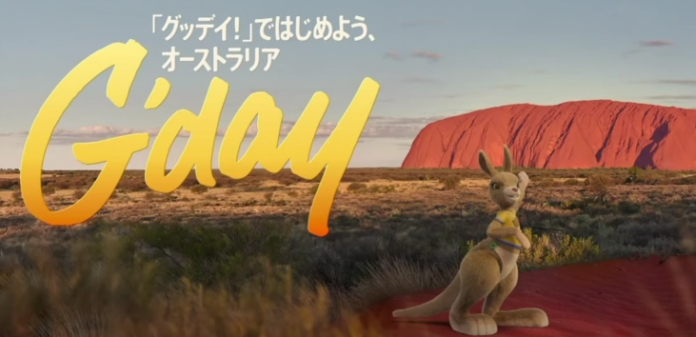Source: 7 News / Tourism Australia
Tourism Australia has unveiled its latest ad campaign designed to win over international visitors, as small businesses nationwide recover from the devastating impact of COVID-19 restrictions — and battle new economic turbulence at home and abroad.
Appearing in Tokyo on Tuesday, Minister for Trade and Tourism Don Farrell officially revealed Ruby the Kangaroo, the fresh face of Australia’s international tourism brand.
Voiced by Australian actor Rose Byrne, Ruby the Roo, a fluffy, computer-generated mascot, will grace billboards in Shinjuku, Singapore, London and New York.
Promotional material will also showcase some of Australia’s most notable tourist destinations, including Uluru.
Get daily business news.
The latest stories, funding information, and expert advice. Free to sign up.
The campaign will help convert “the pent-up demand for an Australian holiday into bookings” across 15 international markets, Farrell said.
New campaign arrives as old tourist markets drop off
The campaign, the latest installment in Tourism Australia’s international There’s Nothing Like Australia PR push, places a significant amount of pressure on a digital marsupial to undo the damage caused by punishing border closures.
New data from the Australian Bureau of Statistics reveals that nearly eight months after the nation’s border fully reopened to international visitors, tourism numbers are still dramatically below pre-COVID levels.
More than 348,000 short-term visits to Australia were logged in August 2022, the data shows, up from just 6390 in August 2021.
But the number of short-term trips recorded in August this year was less than half of the 789,000 tallied in pre-pandemic August 2019.
Compounding the matter is the drop-off in tourism from China.
While the new ad campaign targets Singapore, the US, the UK, and Japan — already ranked third, fourth, fifth, and sixth in terms of short-term visitor arrivals in August — Australia recorded just 8390 short-term visitor arrivals from China over the month.
In pre-pandemic August 2019, that figure stood at 128,280, more than any other nation.
China’s tight lockdown and border control measures in response to new COVID-19 waves has constrained travel outside of the country, putting traditional overseas hotspots like Australia at a distinct disadvantage.
Global currency fluctuations are also wreaking havoc on overseas tourists, who may put off their travel plans should their purchasing power diminish.
And the threat of another La Niña weather system could yet hamper another peak tourist season for operators on the east coast.
Businesses seek support beyond a digital kangaroo
Margy Osmond, head of peak tourism industry body the Tourism and Transport Forum, said the new campaign will build on Australia’s established international brand.
“We need targeted campaigns like this, backed by market research, to help entice overseas visitors to return to our shores once again,” she told SmartCompany.
“While domestic tourism has bounced back, international visitors to Australia are still well below pre-Covid levels and local tourism operators are still hurting.
“This campaign will help remind the world that Australia’s borders are open and that our tourism industry is keen to welcome more guests.”
Backdropped by Australia’s ongoing COVID-19 recovery, and with further economic turmoil likely, smaller tourism operators suggest the local industry needs more than just a cute ad campaign to revitalise the sector.
Jen Clark, founder of sustainable tourist accommodation directory Hosting With Heart, fears the campaign leans too heavily on “cliched” and “unsophisticated” representations.
The sector would benefit if international campaigns took the “move towards more nuanced advertising that represents the incredible diversity of experiences available here,” she tells SmartCompany.
Further opportunities lie in promoting ethical and sustainable tourist attractions to overseas audiences, she adds.
“Travellers are becoming way more savvy about choosing holiday destinations that they feel align with their personal values, especially those in younger demographics.
“The government needs to better reward those operators who are motivated to improve the ethics of the sector as a whole.”
While federal and state governments have already rolled out tens of millions of dollars in grants to tourism operators hampered by pandemic restrictions, Clark says the public sector could still “better support smaller operators” through training and mentorship opportunities.










